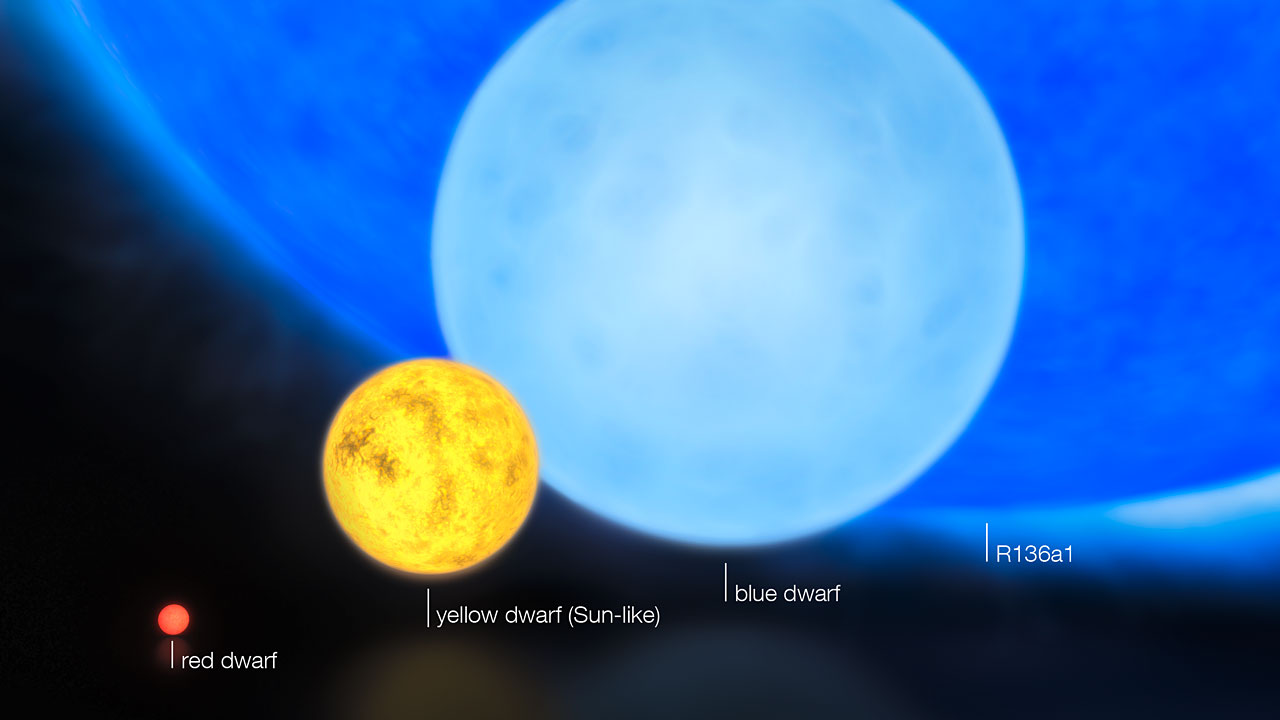Mystery of the 'Monster Stars' Solved: It Was a Monster Mash

A gaggle of monsters resides in the Tarantula Nebula, part of a nearby galaxy.
Scientists discovered four monstrously heavy stars there in 2010. With masses up to 300 times that of our sun, they have twice the mass that astronomers believed to be the upper limit for stars, confounding the known models of star formation and begging the question: how did these monstrosities become so gargantuan?
Now, new calculations reveal that the stars could have been created when pairs of lighter stars that were orbiting one another in a binary star system crashed together and merged. In other words, it was a monster mash.
"Imagine two bulky stars closely circling each other but where the duo gets pulled apart by the gravitational attraction from their neighboring star," said lead investigator Sambaran Banerjee, an astronomer at the University of Bonn in Germany, in a press release. "If their initially circular orbit is stretched enough, then the stars crash into each other as they pass and make a single ultramassive star."
Cracking the mystery required a truly monstrous calculation. Banerjee and colleagues computer-modeled the interactions between stars in an R136-like cluster — R136 being the stellar nursery inside the Tarantula Nebula where the four ultramassive stars arose. The Tarantula Nebula, a 1,000-light-year-diameter cloud of gas and dust also known as the "30 Doradus" (30 Dor) complex, is itself located in the Large Magellanic Cloud, the third closest galaxy to the Milky Way. [Tarantula Nebula's Star-Forming Turbulence Exposed]
The researchers' R136-like cluster model contained more than 170,000 stars, all of which started out with normal mass and which were distributed throughout space in the expected way. To compute how this system changes over time, the computer simulation had to solve a system of 510,000 equations many times over, accounting for such effects as gravity, the nuclear reactions and hence energy released by each star, and what happens when two stars collide.
"With all these ingredients, our R136 models are the most difficult and intensive N-body calculations ever made," said Pavel Kroupa and Seungkyung Oh, members of the research team, referring to the highly intensive star-by-star calculations used to accurately model any number (N) of bodies (stars). The researchers used an N-body integration code developed primarily by an astronomer at Cambridge, and found a novel way of speeding up their calculations using video-gaming cards installed in otherwise ordinary computers.
Get the world’s most fascinating discoveries delivered straight to your inbox.
Presenting their results in an upcoming issue of the journal Monthly Notices of the Royal Astronomical Society, the Bonn group found that "monster stars" formed in their model R136-like cluster. Each started out as a binary pair of bulky but ordinary stars, no heavier than the universal limit of 150 solar masses. At some point, the gravitational pull of nearby stars threw their orbits for a loop, causing the pair to smack together.
"Although extremely complicated physics is involved when two very massive stars collide," Banerjee said, "we still find it quite convincing that this explains the monster stars seen in the Tarantula."
He added, "This helps us relax, because the collisions mean that the ultramassive stars are a lot easier to explain. The universality of star formation prevails after all."
This story was provided by Life's Little Mysteries, a sister site to LiveScience. Follow Natalie Wolchover on Twitter @nattyover or Life's Little Mysteries @llmysteries. We're also on Facebook & Google+.
Natalie Wolchover was a staff writer for Live Science from 2010 to 2012 and is currently a senior physics writer and editor for Quanta Magazine. She holds a bachelor's degree in physics from Tufts University and has studied physics at the University of California, Berkeley. Along with the staff of Quanta, Wolchover won the 2022 Pulitzer Prize for explanatory writing for her work on the building of the James Webb Space Telescope. Her work has also appeared in the The Best American Science and Nature Writing and The Best Writing on Mathematics, Nature, The New Yorker and Popular Science. She was the 2016 winner of the Evert Clark/Seth Payne Award, an annual prize for young science journalists, as well as the winner of the 2017 Science Communication Award for the American Institute of Physics.




